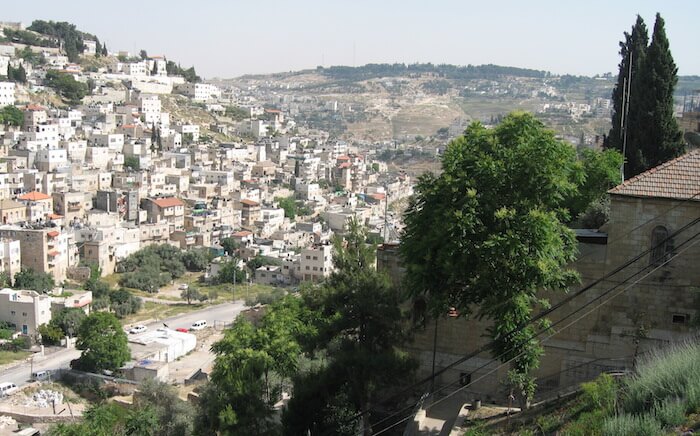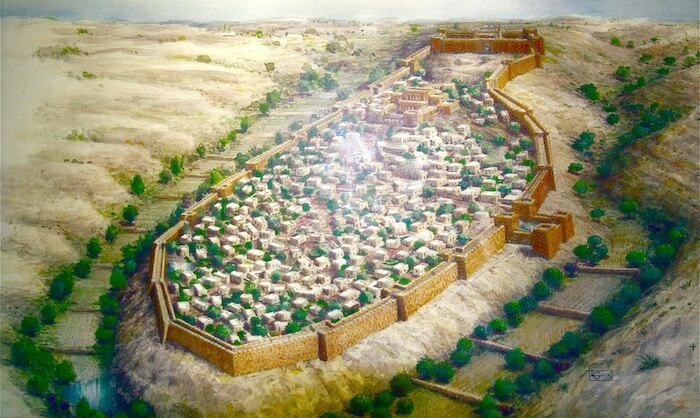When people picture the city of Jerusalem, they usually think of the historic Western Wall, or the Old City, or the Temple Mount crowned with the Golden Dome of the Rock. But people on our tour were surprised to learn that the original city of Jerusalem lay just south of the Temple Mount on a small spur of land that encompassed about only ten acres.

(Photo: City of David at right, and Kidron Valley)
Crammed with houses and punctured with archaeological digs, the original area of Jerusalem looks much different today than it did three thousand years ago when King David conquered it.
Today, this part of Jerusalem retains the name, “The City of David,” and offers a number of archeological interests that relate to the monarch. The best way to view the area is to ascend the stairs just inside the entrance to the Visitor’s Center and stand atop the observation platform.
Check it out from Google Street View. Go ahead and click around:
The City of David
Flanked on two sides by steep valleys, the ancient City of David enjoyed a tremendous military advantage—making it relatively easy to defend.
- At the summit, a stepped-stone structure represents one of the largest Iron Age constructions ever excavated, dating from the 12th Century BC.
- Many archaeologists believe it likely supported the palace of King David, the ruins of which are partially visible after descending some stairs.
From the vantage on the platform, it’s plain to see how David could easily have looked down over the homes built on the slope below him and seen Bathsheba bathing that fateful evening. The modern-day village of Silwan, just across the Kidron Valley from the City of David, has its homes constructed in a similar way.

(A photo I took of a how the City of David may have appeared in David’s day)
Two relatively recent finds are nothing short of thrilling.
- In 2004 Reich and Shukrun found the first-century Pool of Siloam (known as the lower pool).
- They also recently discovered a road that led from this major water source up to the Temple Mount. First-century Jews would have used this road during their pilgrim feasts—most notably during Sukkot. Both the road and the drainage system are available for visitors to view.
Not surprisingly, a number of archaeologists today express their doubts that the entire City of David ever was included in the original Jerusalem. But the conspicuous location of the Gihon Spring seems a hard fact to sidestep. Moreover, the discovery of Warren’s Shaft by Charles Warren in 1867 and the fortifications around the nearby Spring House reveal that the locals clearly made use of the spring in David’s day. It seems far more likely that this small area of land was the same place David conquered.
Of course, the city expanded to the north during David’s time when he purchased the hill that would become the Temple Mount under Solomon’s rule.
- This area the Bible identifies as Mount Moriah, the place where Abraham bound his son Isaac in order to offer him to the Lord (Genesis 22:2; 2 Chronicles 3:1).
- During the time of Hezekiah, the city enlarged again to encompass the Western Hill in order to house and protect fleeing refugees from the northern tribes after their kingdom fell to Assyria.
Arguably the most important city in history had its infancy in an area that today hardly reflects its grandeur.
Jesus was like that. So are we.
Continue Your Tour!
Learn more about each of these sites we saw, including devotionals for each one, by exploring these links:
